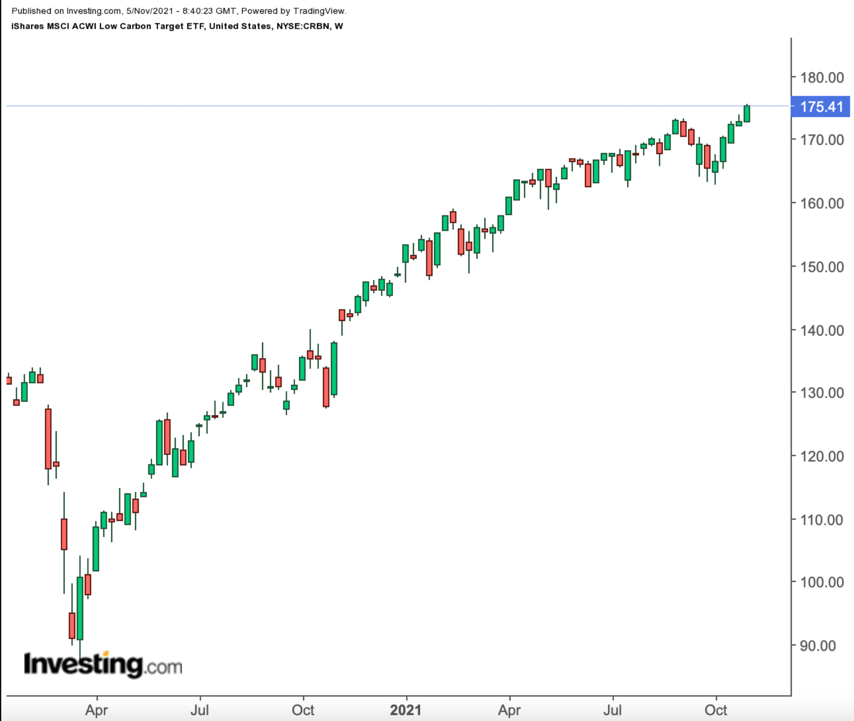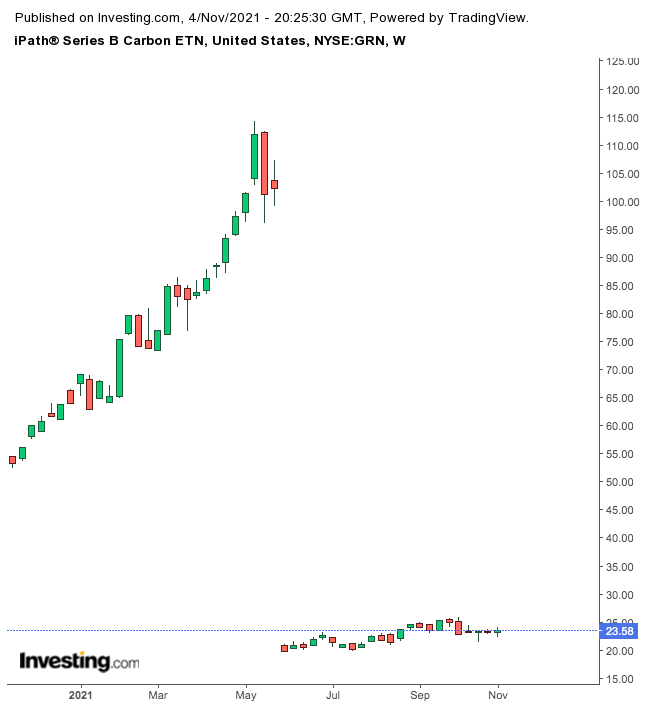The COP26 climate summit in Glasgow, Scotland, has set out several objectives. One aim would be for countries to “come forward with ambitious 2030 emissions reductions targets that align with reaching net zero by the middle of the century.”
Currently, the top carbon dioxide (CO2) emitters are China, the US, India, Russia, Japan and Germany. High-income countries and regions, including the US, the European Union and UK, are set for becoming climate-neutral by 2050. China’s target year is 2060. And India has recently set 2070 as an objective.
We recently covered several exchange-traded products (ETPs) that could appeal to readers wishing to participate in the decarbonization of global economies as well as in companies that are leading the transition to alternative energies or that do not rely much on fossil fuels (here and here). Today’s discussion introduces two more funds.
1. iShares MSCI ACWI Low Carbon Target ETF
- Current Price: $175.41
- 52-Week Range: $137.55 - $175.63
- Dividend Yield: 1.27%
- Expense Ratio: 0.20% per year
The US Energy Information Administration (EIA) highlights:
“Most of the emissions of human-caused (anthropogenic) greenhouse gases (GHG) come primarily from burning fossil fuels—coal, natural gas and petroleum—for energy use.”
The iShares MSCI ACWI Low Carbon Target ETF (NYSE:CRBN) invests in global businesses that are deemed as less dependent on fossil fuels. The fund started trading in December 2014, and has around $1.32 billion in assets.
CRBN, which tracks the returns of the MSCI ACWI Low Carbon Target Index, has 1,350 holdings. In terms of the sub-sectoral breakdown, the information technology sector makes up the largest portion (22.25%), followed by financials and consumer discretionary firms, with 15.30% and 12.55%, respectively. The leading 10 names comprise 15.76% of the fund.
Among the leadings stocks on the roster are the widely-followed tech giants Apple (NASDAQ:AAPL), Microsoft (NASDAQ:MSFT), Amazon (NASDAQ:AMZN), Alphabet (NASDAQ:GOOG) (NASDAQ:GOOGL), Meta Platforms (NASDAQ:FB); Tesla (NASDAQ:TSLA); chip heavyweights NVIDIA (NASDAQ:NVDA) and Taiwan Semiconductor Manufacturing (NYSE:TSM); and global banking group JPMorgan Chase (NYSE:JPM).
Year-to-date, the fund is up about 17.6%, while it has returned more than 32% in the past 12 months. CRBN hit a record high in recent days. Readers interested in the diversified nature of the ETF should research it further with a view to buy around $170 or less.
2. iPathA Series B Carbon
- Current Price: $23.58
- 52-Week Range: $9.72 - $25.80
- Expense Ratio: 0.79% per year
Here we can continue an earlier discussion we had on the carbon cap-and-trade system, which “allows the market to determine a price on carbon, and that price drives investment decisions and spurs market innovation.”
The iPath® Series B Carbon ETN (NYSE:GRN) is an exchange-traded note that tracks the Barclays Global Carbon II TR USD Index. This index gives exposure to the price of carbon as determined by futures contracts on carbon emissions credits mostly from the European Union Emission Trading Scheme (EU ETS).

Although fund managers have the discretion to allocate part of the fund to futures contracts associated with the Kyoto Protocol’s Clean Development Mechanism (CDM), since inception their weighting has been less than 0.1%.
A carbon credit is “an emissions unit that is issued by a carbon-crediting program and represents an emission reduction or removal of greenhouse gases. Carbon credits are uniquely serialized, issued, tracked and cancelled by means of an electronic registry.”
Currently, the EU ETS is the world’s major emissions-reduction mechanism, placing a cap on carbon that can be emitted. Enterprises that need to emit more than that cap have to buy credits. Otherwise, they would be fined. Historically, utilities have been major purchasers of credit allowances.
There is a liquid futures market where futures contracts on Emissions Allowances can be purchased. The futures contracts that the ETN trades are listed on the ICE Futures Europe exchange.
Since inception in September 2019, GRN’s net assets have reached $81.8 million. So far in 2021, the ETN has returned more than 83.5%.
The fund could appeal to readers who want to participate in the leading system for decreasing greenhouse gas emissions. But we should highlight that the index components are denominated in euros. Therefore, holders of the ETN are affected by currency fluctuations. If the euro depreciates against the US dollar, the level of the index will be adversely affected.
